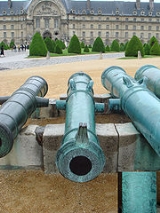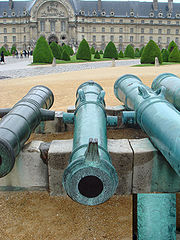
Musée de l'Armée
Encyclopedia

Les Invalides
Les Invalides , officially known as L'Hôtel national des Invalides , is a complex of buildings in the 7th arrondissement of Paris, France, containing museums and monuments, all relating to the military history of France, as well as a hospital and a retirement home for war veterans, the building's...
in Paris
Paris
Paris is the capital and largest city in France, situated on the river Seine, in northern France, at the heart of the Île-de-France region...
, France
France
The French Republic , The French Republic , The French Republic , (commonly known as France , is a unitary semi-presidential republic in Western Europe with several overseas territories and islands located on other continents and in the Indian, Pacific, and Atlantic oceans. Metropolitan France...
. Originally built as a hospital and home for disabled soldiers by Louis XIV, it now houses the Tomb of Napoleon and the museum of the Army of France. The museum's collections cover the time period from antiquity until the 20th century.
The museum was established, under the name Musée de l'artillerie (Museum of Artillery - "artillerie" then meant all things related to weapons), in 1871, immediately after the defeat during the Franco-Prussian War
Franco-Prussian War
The Franco-Prussian War or Franco-German War, often referred to in France as the 1870 War was a conflict between the Second French Empire and the Kingdom of Prussia. Prussia was aided by the North German Confederation, of which it was a member, and the South German states of Baden, Württemberg and...
and the proclamation of the Third Republic
French Third Republic
The French Third Republic was the republican government of France from 1870, when the Second French Empire collapsed due to the French defeat in the Franco-Prussian War, to 1940, when France was overrun by Nazi Germany during World War II, resulting in the German and Italian occupations of France...
, in the Hôtel des Invalides.
In March 1878, the museum hosted an "ethnographic
Ethnography
Ethnography is a qualitative method aimed to learn and understand cultural phenomena which reflect the knowledge and system of meanings guiding the life of a cultural group...
exhibition", as it was called, which represented the main "types" of Oceania
Oceania
Oceania is a region centered on the islands of the tropical Pacific Ocean. Conceptions of what constitutes Oceania range from the coral atolls and volcanic islands of the South Pacific to the entire insular region between Asia and the Americas, including Australasia and the Malay Archipelago...
, America
Americas
The Americas, or America , are lands in the Western hemisphere, also known as the New World. In English, the plural form the Americas is often used to refer to the landmasses of North America and South America with their associated islands and regions, while the singular form America is primarily...
, Asia
Asia
Asia is the world's largest and most populous continent, located primarily in the eastern and northern hemispheres. It covers 8.7% of the Earth's total surface area and with approximately 3.879 billion people, it hosts 60% of the world's current human population...
and Africa
Africa
Africa is the world's second largest and second most populous continent, after Asia. At about 30.2 million km² including adjacent islands, it covers 6% of the Earth's total surface area and 20.4% of the total land area...
. Dummies representing people from the colonies
French colonial empire
The French colonial empire was the set of territories outside Europe that were under French rule primarily from the 17th century to the late 1960s. In the 19th and 20th centuries, the colonial empire of France was the second-largest in the world behind the British Empire. The French colonial empire...
, along with weapons and equipment, were the main attraction. The exhibit, organized by colonel Le Clerc, attempted to demonstrate theories of unilineal evolution
Unilineal evolution
Unilineal evolution is a 19th century social theory about the evolution of societies and cultures. It was composed of many competing theories by various sociologists and anthropologists, who believed that Western culture is the contemporary pinnacle of social evolution...
, putting the European man at the apex of human history . Parts of this collection began to be transferred to the Ethnographic Museum of the Trocadéro
Musée de l'Homme
The Musée de l'Homme was created in 1937 by Paul Rivet for the 1937 Exposition Internationale des Arts et Techniques dans la Vie Moderne. It is the descendant of the Musée d'Ethnographie du Trocadéro, founded in 1878...
in 1910 and in 1917; the last colonial rooms were closed just after the 1931 Paris Colonial Exhibition . All remnants were transferred after the Second World War .
A Musée historique de l'Armée (Historical Museum of the Army) was also created in 1896. It merged in 1905 with the Musée de l'Artillerie creating the current Museum. Today, it holds 500,000 artifacts, including weapons, armour, artillery, uniforms, emblems and paintings, exhibited in an area of 12,000 m². The permanent collections are organized into "historical collections", representing a chronological tour from ancient times through the end of World War II
World War II
World War II, or the Second World War , was a global conflict lasting from 1939 to 1945, involving most of the world's nations—including all of the great powers—eventually forming two opposing military alliances: the Allies and the Axis...
.

